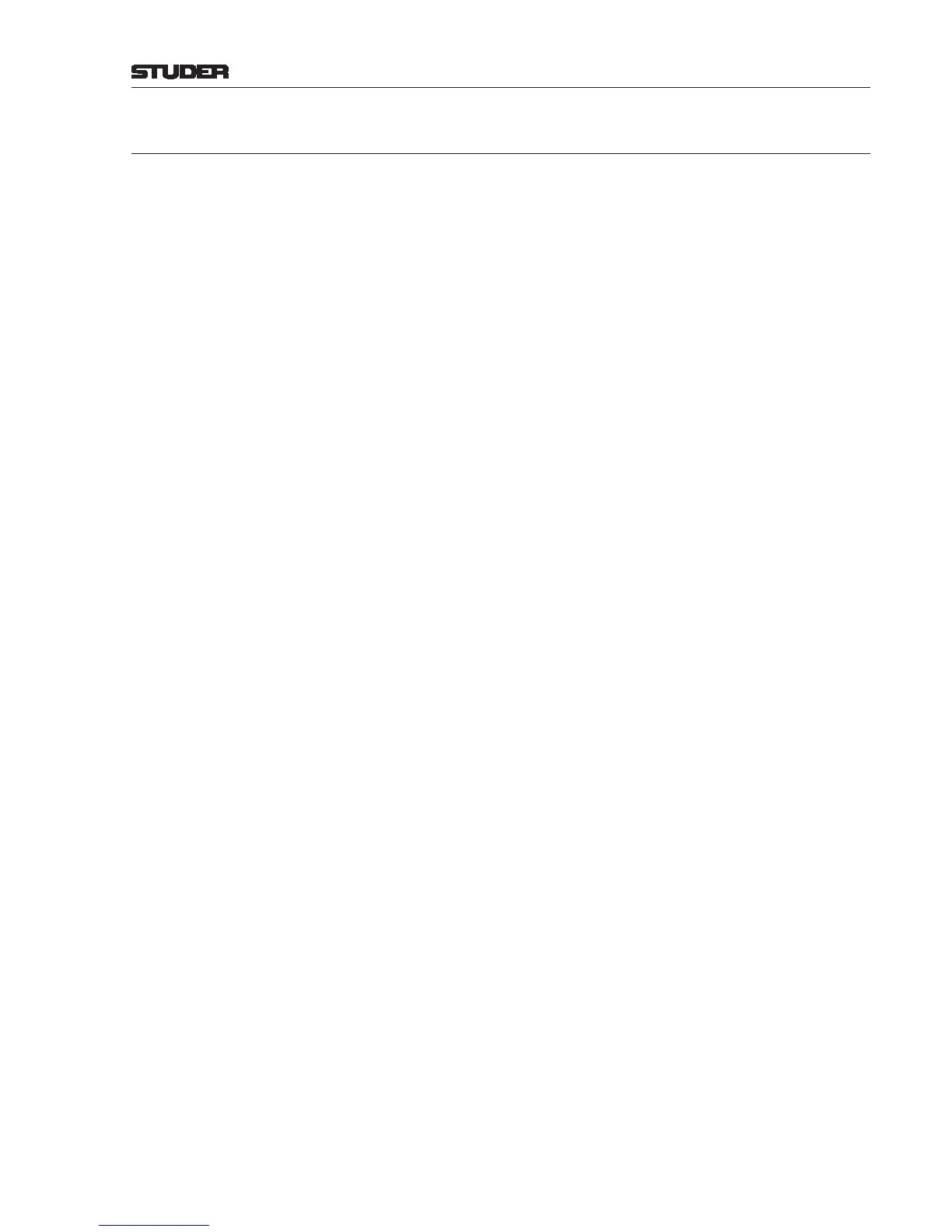OnAir 2500/OnAir 3000 Digital Mixing Consoles
Conguration 6-7
Date printed: 22.07.08
SW V3.0
6.1.2 Desk Init
Note: Desk Init is not a factory reset function; it is, however, the basic initialization
of specic parameters as listed below, according to pre-dened rules.
When touching the Desk Init button on the Admin - Cong page, the fol-
lowing selections are initialized with the specied values:
Rotary Assign Functions • Fader assign module: A key mapping according to the illustration in chapter
4.5.1 is assigned to the fader assign module.
• * Rotary assign module: A key mapping according to the illustration in
chapter 4.7 is assigned to the rotary assign module.
The current assignment will be BALANCE for the fader assign module, and
AUX for the rotary assign module.
Master Outs • All 23 summing buses (and, if the subgroup option is installed, the eight
subgroups) are part of this selection.
Input Sel Groups • All eight input group selections (Sel_Inp_Group1...8) are part of all eight
group selections.
Input Routing • All eight input group selections (Sel_Inp_Group1...8) and the MasterOuts
are part of the input routing selection.
Output Routing • All eight input group selections and all eight patch group selections (Patch_
Group1...8) as well as the MasterOuts are part of the routing selection.
Master Inserts • All three master summing buses (PRG A, PRG B* and RECORD) and, if
the subgroup option is installed, the eight subgroups) are part of the Master
Inserts group.
Insert Points • All eight input group selections (Sel_Inp_Group1...8) and the Master
Inserts are part of this selection.
Mon Sources CR / ST1* • The following signals can be selected as monitoring sources by the rotary
encoder on the monitoring module: All 23 summing buses, the audition
bus, both PFL buses, all 16 external monitoring sources and, if the subgroup
option is installed, the eight subgroups.
The default rotary source is PRG A.
3
rd
HP Source CR / ST1* • As Mon Sources CR / ST1 (above); the default 3
rd
HP Source is PFL for
the control room (CR) and Studio PFL for studio 1 (ST1).
Meter Sources Meter 1...4 • For the main level meters 1 and 3, PRG A, PRG B*, and RECORD can
be selected; for meters 2 and 4, the following signals can be selected:
FollowCRMon, FollowST1Mon*, FollowST2Mon, FollowST3Mon*, all
AUX buses, all N–X buses and, if the subgroup option* is installed, the
eight subgroups. The default meter sources are PRG A for meters 1/3, and
FollowCRMon for meters 2/4.
Monitoring Source Selector Keys 1...20 for CR and ST1*
• A key mapping according to the illustration in chapter 6.5.27.1 is assigned
to the monitoring source selector keys of the CR and *ST1 TB/monitoring
modules.
CR TB Destination Keys 1...16 • A key mapping according to the illustration in chapter 6.5.27.1 is assigned
to the talkback destination keys 1...16 of the CR TB/monitoring module.
ST1 TB Destination Keys 1...16* • A key mapping according to the illustration in chapter 6.5.27.1 is assigned
to the talkback destination keys 1...16 of the *ST1 TB/monitoring module,
but with TB to CR instead of TB to ST1
Key Input Selection (for Ducking)* • None, all LogicalInputs, AUX1...4, N–X1...16 (and, if subgroup option
installed: SubGroup1...8).
All other conguration settings remain unchanged.
* supported by OnAir 3000 only.
